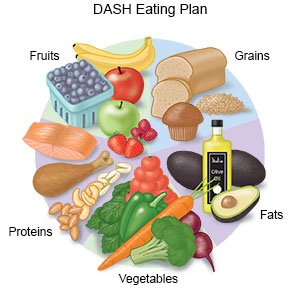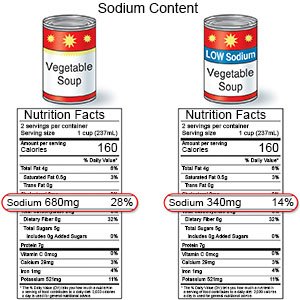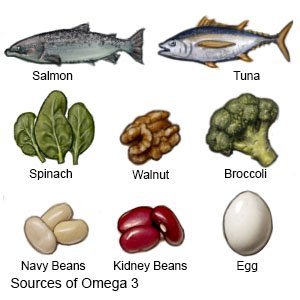Dash Eating Plan
Medically reviewed by Drugs.com. Last updated on Apr 6, 2025.
What is the DASH Eating Plan?
The DASH (Dietary Approaches to Stop Hypertension) Eating Plan is designed to help prevent or lower high blood pressure. It can also help to lower LDL (bad) cholesterol and decrease your risk for heart disease. The plan is low in sodium, sugar, unhealthy fats, and total fat. It is high in potassium, calcium, magnesium, and fiber. These nutrients are added when you eat more fruits, vegetables, and whole grains. With the DASH eating plan, you need to eat a certain number of servings from each food group. This will help you get enough of certain nutrients and limit others. The amount of servings you should eat depends on how many calories you need. Your dietitian can help you create meal plans with the right number of servings for each food group.
 |
What do I need to know about sodium?
Your dietitian will tell you how much sodium is safe for you to have each day. People with high blood pressure should have no more than 1,500 to 2,300 mg of sodium in a day. A teaspoon (tsp) of salt has 2,300 mg of sodium. This may seem like a difficult goal, but small changes to the foods you eat can make a big difference. Your healthcare provider or dietitian can help you create a meal plan that follows your sodium limit.
- Read food labels. Food labels can help you choose foods that are low in sodium. The amount of sodium is listed in milligrams (mg). The % Daily Value (DV) column tells you how much of your daily needs are met by 1 serving of the food for each nutrient listed. Choose foods that have less than 5% of the DV of sodium. These foods are considered low in sodium. Foods that have 20% or more of the DV of sodium are considered high in sodium. Avoid foods that have more than 300 mg of sodium in each serving. Choose foods that say low-sodium, reduced-sodium, or no salt added on the food label.

- Limit added salt. Do not salt food at the table if you add salt when you cook. Use herbs and spices, such as onions, garlic, and salt-free seasonings to add flavor. Try lemon or lime juice or vinegar to add a tart flavor. Use hot peppers or a small amount of hot pepper sauce to add a spicy flavor. Limit foods high in added salt, such as the following:
- Seasonings made with salt, such as garlic salt, celery salt, onion salt, seasoned salt, meat tenderizers, and monosodium glutamate (MSG)
- Miso soup and canned or dried soup mixes
- Regular soy sauce, barbecue sauce, teriyaki sauce, steak sauce, Worcestershire sauce, and most flavored vinegars
- Snack foods, such as salted chips, popcorn, pretzels, pork rinds, salted crackers, and salted nuts
- Frozen foods, such as dinners, entrees, vegetables with sauces, and breaded meats
- Ask about salt substitutes. Ask your healthcare provider if you may use salt substitutes. Some salt substitutes have ingredients that can be harmful if you have certain health conditions.
- Choose foods carefully at restaurants. Meals from restaurants, especially fast food restaurants, are often high in sodium. Some restaurants have nutrition information that tells you the amount of sodium in their foods. Ask to have your food prepared with less, or no salt.
What do I need to know about fats?
Healthy fats include unsaturated fats and omega-3 fatty acids. Unhealthy fats include saturated fats and trans fats.
- Include healthy fats, such as the following:
- Cooking oils, such as soybean, canola, olive, or sunflower
- Fatty fish, such as salmon, tuna, mackerel, or sardines
- Flaxseed oil or ground flaxseed
- ½ cup of cooked beans, such as black beans, kidney beans, or pinto beans
- 1½ ounces of low-sodium nuts, such as almonds or walnuts
- Low-sugar, low-sodium peanut butter
- Seeds such as chia seeds or sunflower seeds

- Limit or do not have unhealthy fats, such as the following:
- Foods that contain fat from animals, such as fatty meats, whole milk, butter, and cream
- Shortening, stick margarine, palm oil, and coconut oil
- Full-fat or creamy salad dressing
- Creamy soup
- Crackers, chips, and baked goods made with margarine or shortening
- Foods that are fried in unhealthy fats
- Gravy and sauces, such as Alfredo or cheese sauces
What do I need to know about carbohydrates (carbs)?
All carbs break down into sugar. Complex carbs contain more fiber than simple carbs. This means complex carbs go into the bloodstream more slowly and cause less of a blood sugar spike. Try to include more complex carbs and fewer simple carbs.
- Include complex carbs, such as the following:
- 1 slice of whole-grain bread
- 1 ounce of dry cereal that does not contain added sugar
- ½ cup of cooked oatmeal
- 2 ounces of cooked whole-grain pasta
- ½ cup of cooked brown rice
- Limit or do not have simple carbs, such as the following:
- Baked goods, such as doughnuts, pastries, and cookies
- Mixes for cornbread and biscuits
- White rice and pasta mixes, such as boxed macaroni and cheese
- Instant and cold cereals that contain sugar
- Jelly, jam, and ice cream that contain sugar
- Condiments such as ketchup
- Drinks high in sugar, such as soft drinks, lemonade, and fruit juice
Drugs used to treat this and similar conditions
Crestor
Crestor (rosuvastatin) is used to treat high cholesterol and high triglycerides in the blood ...
Ranexa
Ranexa (ranolazine) is used to chronic treat angina (chest pain). Learn about side effects ...
Omvoh
Omvoh is used to treat moderate to severe ulcerative colitis or Crohn's disease in adults. This ...
Tylenol
Tylenol is a pain reliever and a fever reducer used to treat many conditions such as headaches ...
Dilaudid
Dilaudid (hydromorphone) is a narcotic pain reliever used to treat moderate to severe pain ...
Ibuprofen
Ibuprofen (Advil, Motrin) treats minor aches and pains caused by the common cold, headaches ...
Losartan
Losartan is used to treat high blood pressure (hypertension). It is also used to lower the risk of ...
Gabapentin
Gabapentin is an anti-epileptic drug, also called an anticonvulsant. It is used to treat some types ...
Amlodipine
Amlodipine is a calcium channel blocker used to treat high blood pressure and angina by relaxing ...
What do I need to know about vegetables and fruits?
Vegetables and fruits can be fresh, frozen, or canned. If possible, try to choose low-sodium canned options.
- Include a variety of vegetables and fruits, such as the following:
- 1 medium apple, pear, or peach (about ½ cup chopped)
- ½ small banana
- ½ cup berries, such as blueberries, strawberries, or blackberries
- 1 cup of raw leafy greens, such as lettuce, spinach, kale, or collard greens
- ½ cup of frozen or canned (no added salt) vegetables, such as green beans
- ½ cup of fresh, frozen, or canned fruit (canned in light syrup or fruit juice)
- ½ cup of vegetable or fruit juice
- Limit or do not have vegetables and fruits made in the following ways:
- Frozen fruit such as cherries that have added sugar
- Fruit in cream or butter sauce
- Canned vegetables that are high in sodium
- Sauerkraut, pickled vegetables, and other foods prepared in brine
- Fried vegetables or vegetables in butter or high-fat sauces
What do I need to know about protein foods?
- Include lean or low-fat protein foods, such as the following:
- Poultry (chicken, turkey) with no skin
- Fish (especially fatty fish, such as salmon, fresh tuna, or mackerel)
- Lean beef and pork (loin, round, extra lean hamburger)
- Egg whites and egg substitutes
- 1 cup of nonfat (skim) or 1% milk
- 1½ ounces of fat-free or low-fat cheese
- 6 ounces of nonfat or low-fat yogurt
- Limit or do not have high-fat protein foods, such as the following:
- Smoked or cured meat, such as corned beef, bacon, ham, hot dogs, and sausage
- Canned beans and canned meats or spreads, such as potted meats, sardines, anchovies, and imitation seafood
- Deli or lunch meats, such as bologna, ham, turkey, and roast beef
- High-fat meat (T-bone steak, regular hamburger, and ribs)
- Whole eggs and egg yolks
- Whole milk, 2% milk, and cream
- Regular cheese and processed cheese
What other guidelines should I follow?
- Maintain a healthy weight. Your risk for heart disease is higher if you have extra weight. Ask your healthcare provider what a healthy weight is for you. Your provider may suggest that you lose weight. You can lose weight by eating fewer calories and foods that have added sugars and fat. The DASH meal plan can help you do this. Decrease calories by eating smaller portions at each meal and fewer snacks. Ask your provider for more information about how to lose weight.
- Exercise regularly. Regular exercise can help you reach or maintain a healthy weight. Regular exercise can also help decrease your blood pressure and improve your cholesterol levels. Get 30 minutes or more of moderate exercise each day of the week. To lose weight, get at least 60 minutes of exercise. Talk to your healthcare provider about the best exercise program for you.

- Limit alcohol. Women should limit alcohol to 1 drink a day. Men should limit alcohol to 2 drinks a day. A drink of alcohol is 12 ounces of beer, 5 ounces of wine, or 1½ ounces of liquor.
Where can I find more information?
- National Heart, Lung and Blood Institute
Health Information Center
P.O. Box 30105
Bethesda , MD 20824-0105
Phone: 1- 301 - 592-8573
Web Address: http://www.nhlbi.nih.gov/health/infoctr/index.htm
Care Agreement
You have the right to help plan your care. Discuss treatment options with your healthcare provider to decide what care you want to receive. You always have the right to refuse treatment. The above information is an educational aid only. It is not intended as medical advice for individual conditions or treatments. Talk to your doctor, nurse or pharmacist before following any medical regimen to see if it is safe and effective for you.© Copyright Merative 2025 Information is for End User's use only and may not be sold, redistributed or otherwise used for commercial purposes.
Further information
Always consult your healthcare provider to ensure the information displayed on this page applies to your personal circumstances.
